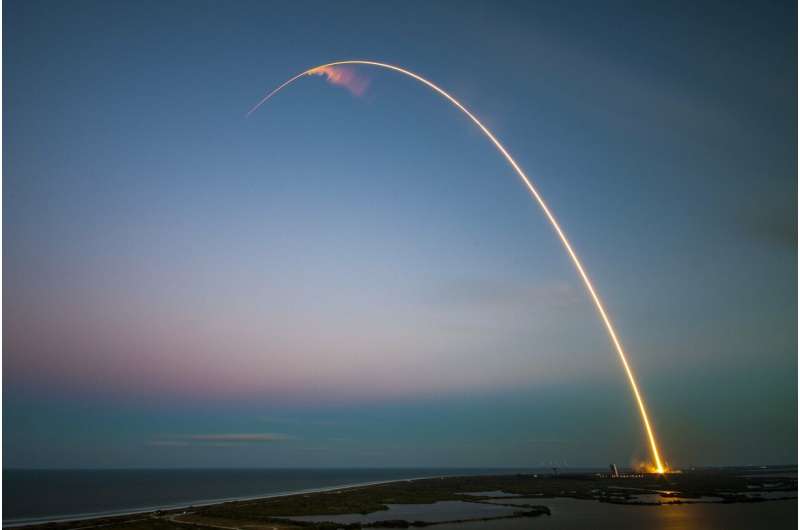This article has been reviewed according to Science X's editorial process and policies. Editors have highlighted the following attributes while ensuring the content's credibility:
fact-checked
reputable news agency
proofread
NASA's tale of two towers: Both Artemis mobile launchers see action

NASA's Artemis program has one tower standing and one just getting started.
Mobile launcher 1 (ML-1), which endured some significant damage after its use on the Artemis I mission last November, has been undergoing repairs and enhancements in preparation for its reuse on next year's planned Artemis II flight, the first with humans on board.
NASA stuck the 380-foot-tall structure atop its slow-moving crawler-transporter 2 on Wednesday at Kennedy Space Center to begin its two-day return to Launch Pad 39-B.
ML-1 is the ground structure that holds NASA's powerful Space Launch System rocket, and for Artemis II, NASA has been working to add essential features for the four humans that will be riding in the Orion capsule atop the rocket. It will make its way into the Vehicle Assembly Building for eventual stacking of all the rocket parts early next year.
For now, though, it has work planned at the launch site where NASA's Exploration Ground Systems team will perform tests and work on upgrades for both the launcher and the launch pad. That includes a launch day demonstration for the Artemis II crew of NASA astronauts Reid Wiseman, Victor Glover, Christina Koch and Canadian astronaut Jeremy Hansen as well as NASA's closeout crew and the rescue team.
The rescue teams will make sure the emergency exit system works in the event the astronauts and other support crew need to escape from their spacecraft to the safety of the ground below. The system has four baskets that can hold up to five people that travel down large cables to staged vehicles below.
Unlike the Space Shuttle Program, which had a tower permanently constructed at the launch pad, the mobile launchers require the emergency egress systems to be assembled and disassembled between every SLS launch.
NASA will also be able to test upgraded umbilical lines including the flow of liquid hydrogen from a new storage sphere. Liquid hydrogen leaks plagued both dress rehearsals and several launch attempts before the eventual successful liftoff of Artemis I on Nov. 16, 2022.
Meanwhile, Bechtel National Inc., NASA's prime contractor to construct a sister mobile launcher, bolted together the first pieces of steel Wednesday at KSC for what will end up being the even bigger mobile launcher 2 (ML-2). The slightly taller platform will be 390 feet tall.
The need for a second mobile launcher is driven by what will be a version of SLS that's 40 feet taller called the Block 1B. The height increase is due to SLS getting rid of what's called the Interim Cryogenic Propulsion Stage (ICPS) used to propel the Orion space capsule to the moon in favor of the more powerful and roomier Exploration Upper Stage beginning with Artemis IV, a mission currently on NASA's roadmap for no earlier than 2028.
The steel trusses and girders will come together as it takes shape, eventually to be assembled at the mobile launcher parking lot that's adjacent to the VAB.
"I am proud of our team for achieving this significant milestone in partnership with NASA," said Bechtel Project Manager Felice Presti in a press release. "It is incredible to see the complex designs of my Bechtel colleagues come together in this new, innovative structure that will support the SLS rocket and NASA's Artemis mission to further deep space exploration. I look forward to continuing safe progress on the mobile launcher as we work from bolting to liftoff."
When finished, the ML-2 will weigh about 11.3 million pounds and be able to support the Block 1B version as well as a planned Block 2 version of SLS that is planned to have even more power at liftoff than the first Artemis missions, which produce 8.8 million pounds of thrust on liftoff, and to date is the most powerful rocket to ever reach orbit.
Bechtel was awarded the original contract to construct ML-2 in 2019 for $383 million with a completion originally promised by spring 2023. Cost increases and design delays piled on through 2022 prompting NASA's Office of the Inspector General to audit the program. Its findings released last June showed the total projected cost was already expected to hit $960.1 million, or 2 1/2 times more than originally planned.
Delivery now is officially delayed until October 2025, but the audit suggests even that date won't be attainable.
"We expect further cost increases as inevitable technical challenges arise when ML-2 construction begins," the audit reads. "Given the time NASA requires for additional testing once the structure is delivered, the earliest the ML-2 will be available for Artemis IV is November 2026."
2023 Orlando Sentinel.
Distributed by Tribune Content Agency, LLC.





















